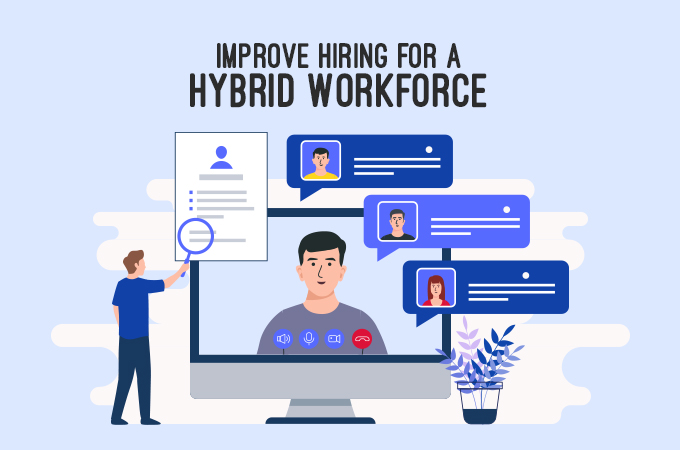With the ease of COVID-19 restrictions globally, many offices have started reopening and asking their employees to start working from the office premises. However, as organizations begin to shift from a fully remote setup it is important to realize that the pandemic has bought a permanent change into how we work. While remote work was considered a job perk before 2020, the pandemic has demonstrated that it can be very successful and is not just a passing trend. The current situation is such that many employees are now considering switching their jobs if they are required to return to the office full-time. Keeping these sentiments in mind, organizations are increasingly adopting the hybrid work model for the future.
The hybrid work model can be difficult to navigate if not managed effectively. The first thing you should consider while creating a hiring strategy for a hybrid workforce is to clearly define and address the expectations. The HR management should be up for the task to recognize and hiring the right talent in the hybrid workspace. In the hybrid model of work, it is more challenging to make employees understand organizational goals, culture, vision, and policies. As we continue to settle into this new space, HR management must formulate strategies to minimize disruption and ensure that employee recruitment and onboarding takes place without any hiccups.
What are the challenges of hiring for a hybrid work model?
- The local talent pool is now going global. The rapid adoption of remote work has opened the geographic talent pool to various opportunities not present before. For recruiters looking for offline projects, it has become challenging to find the right local talent for their advertised jobs. Employers must therefore strive to improve their brand to attract and retain key local talent.
- The high influx of workers in the hybrid model will put a strain on jobs that require in-office presence like logistics, manufacturing, service, etc. This will put a strain on HR staff to find the right talent for these jobs.
With many employees preferring to work remotely, it is important to devise strategies that can make the hybrid work model a success while improving the work-life balance of employees. Here are a few approaches that an organization can embrace to ace the hybrid hiring process.
- Clarify your expectations
To minimize disruptions to your daily operations, it makes sense to clarify your expectations to the new employee during the hiring process. With a hybrid work strategy in place, communicate your work schedule, expectations from them, timings, number of days they are expected to work from the office premises, etc. Communicating your expectations beforehand will reduce friction and improve day-to-day dealings. For example, if there is some employee whose physical presence at the company is crucial, then the possibility of remote work for them is significantly reduced.
- Leverage technology to recruit and onboard effectively
Recruitment modules of many leading HRMS can successfully help you recruit, manage and onboard employees for a hybrid workforce. Applicant tracking systems, collaboration tools, project management, video conferencing will be made easier with technology. Using various collaboration tools will keep everyone on the same page, without alienating anyone and create a harmonious work environment. Innovative technology can supercharge your hiring process, and drastically improve the efficiency of the system. Paylite HRMS can help you effectively recruit and manage talent for your hybrid workforce, without any manual work.
- Create a strong employer brand
The absence of geographic boundaries in hiring has rejuvenated as well as disrupted the regular hiring process. To woo top talent, it has become important to create a strong brand that employees can identify and want to work with. Potential candidates will also search for your organization online before making a final decision. Work on your website, social media and other online platforms to provide an insider view, company culture overview, create a strong connection with employees and build a solid online presence. Candidates must have a clear understanding of the company and its culture so that they can align themselves successfully with the organization and its values.
- Communicate consistently with your candidates
Ghosting employees or leaving them in the lurch for weeks will leave a disastrous impact on your hiring process, now more than ever. Communicate often with the candidate to let them know of the progress and provide a clear understanding of how a hybrid model works at your organization. This helps them to align with the expectations of the organization and deliver accordingly. It helps in creating a long-lasting relationship that will further improve in meeting them in person. Clear communication will boost candidate confidence and display the integrity of the organization. A consistent communication flow establishes transparency and enhances the candidate experience.
- Foster strong connections
A remote or hybrid workforce may often feel disconnected. By not being in the office at all times, they may feel alienated from the company culture, goals, and get frustrated with work. For new employees, it is more important to foster connections and feel encouraged to work and contribute. The HR management must take proactive steps to engage employees and help them align with developmental goals. Send them a care package, organize fun activities, virtual meetings, group activities that foster engagement and build strong employee relationships.
In a hybrid workplace, performance is more important than the hours logged in. People will eventually find their rhythm, but hiring the right staff for the right job is essential. While there are several challenges to hiring for a hybrid workspace, there are numerous benefits that this model poses. Organizations can improve employee work-life balance, thereby reducing their attrition rates. Key talent will be more satisfied and lead to higher productivity across the board. Adjusting to the changes of the new world order will help your organization thrive and ward off any competition.
